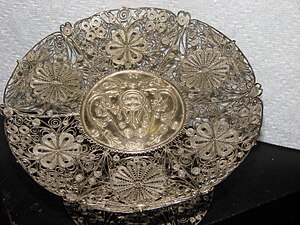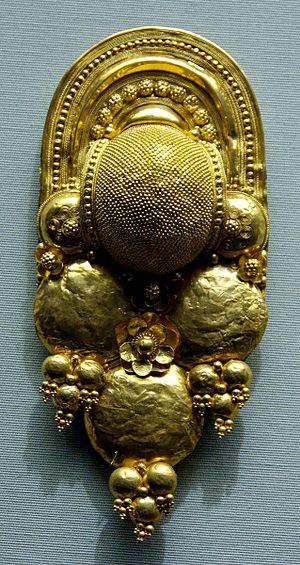So first of all what exactly is Filigree?
Filigree is a technique for creating simple or elaborate designs from square, rectangular, twisted, round, or beaded wire. It can be combined with other techniques, like granulation. One of the most important characteristics of filigree is the use of sweeping spiraling designs. It is possible to do straight geometric forms with filigree, but traditionally this is much less common.
This picture of a decorative dish that was created with filigree shows the amazing complexity that is characteristic of traditional style filigree work.
Filigree can be used to create the entire piece, or just as a surface treatment on a piece of jewelry or sculpture. The technique has been used for thousands of years. The Greeks had developed this technique to a high art by 350 BC. This picture shows filigree, used as a surface decoration on a piece of sculpture from the Tang Dynasty (618 – 907 AD).
Filigree was traditionally executed in gold or silver. Modernly it is usually done in gold, silver, or nickel silver, but technically it could be done using any metal that can be soldered or welded together.
Filigree work can be flat or very three-dimensional. The modern sculptural miniature in this picture is an excellent example of the versatility of filigree as an art form.
How is Filigree created? The technique varies slightly depending on whether it is being used as a stand-alone form, or a surface treatment. If filigree is used as a stand-alone form, care must be taken to the make the piece structurally stable. The wire is carefully formed using fingers and pliers. The pieces of wire are placed together so that they touch. Care should be taken to create a fairly compact form, with no loose coils that might tend to catch on hair or clothing. The individual coils are placed so that they touch. Then flux and solder are applied, and the piece is soldered together.
If the filigree is being used as a surface treatment, the base piece of metal is created first. Once the base piece exists, the filigree is placed on the surface and soldered in place. The major concern is making sure that the filigree is solidly attached to the surface with no loose pieces or pieces that stick out that would snag on things.
Filigree that is used as a surface decoration relies on the piece it is soldered to for structural stability. The form can be as simple as a circle or as complex as the most elaborate spiral flourish.
The gold piece in this picture uses a gold sheet that has been formed with chasing and repousse as it’s structural base. Beaded wire, and spiraled wire (formed into a circle around the center of the largest flower) are combined with granulation and other forms to create this elaborate design.
I hope that this brief blog gives you a basic understanding of the technique of filigree and the complexity of the design and assembly process.
Next time: Overlay




